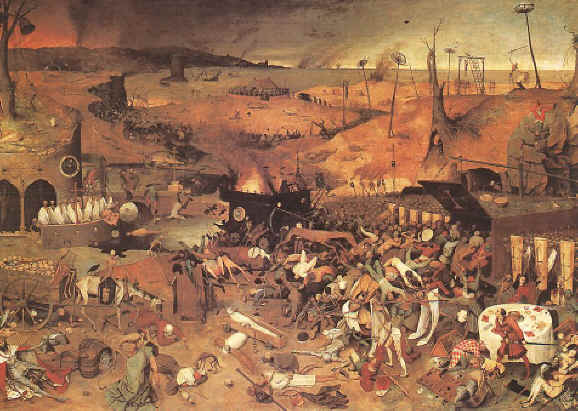“Ring around the rosy,
[refers to the rosy-red (or purple-ish) round rash marks on the skin —one of the first signs a person had the plague]
A pocket full of posies;
[one of the superstitious ways used by people in the Middle Ages to try and fend off the plague was to stuff their pockets with posies (flowers)]
Atischoo, atischoo,
[sneezing was also an early sign of the plague if it was a pneumonic plague; however, not all types of plague involved sneezing]
or, Ashes, ashes
[the dead were often cremated]
We all fall down.
[most of the people stricken with the plague died]” (source)
“The plague came to Europe in the fall of 1347. By 1350 it had largely passed out of western Europe. In the space of two years, one out of every three people was dead. Nothing like that has happened before or since. These general numbers disguise the uneven nature of the epidemic. Some areas suffered little, others suffered far more. Here are some examples. Between 45% and 75% of Florence died in a single year. One-third died in the first six months. Its entire economic system collapsed for a time. In Venice, which kept excellent records, 60% died over the course of 18 months: five hundred to six hundred a day at the height.” (source)

“Medical professionals calculated that dead bodies, poor ventilation, and the close quarters so common in medieval towns brought plague [besides the main cause of fleas on rats.] This led to government regulations, in particular, the decision to bury cadavers outside the town walls. Priests were told to keep sermons short and disperse congregations early.” (Gottfried 69) The people would burn the corpses, clothes, and bedding, then spray the bedroom with incense. Good smells were believed to help fight off disease.
“The disease struck and killed people with terrible speed. The Italian writer Boccaccio said its victims often ‘ate lunch with their friends and dinner with their ancestors in paradise.’” (source) “Symptoms [of the plague] include high fever, chills, headache, exhaustion, a skin rash and the namesake "buboes" — hideously enlarged and swollen lymph nodes.” (source)
“The Bubonic Plague continued to affect cities from time to time for hundreds of years. It still exists and is common among rodents. We have a cure for the disease, but occasionally people in isolated places still die from the Bubonic Plague.” (source)
Works Cited
Cantor, Norman. In the Wake of the Plague: The Black Death & the World it Made. New York: The Free Press. 2001.
Gottfried, Robert S. The Black Death: Natural and Human Disaster in Medieval Europe. New York: The Free Press. 1983.



1 comment:
5,5,5
Post a Comment